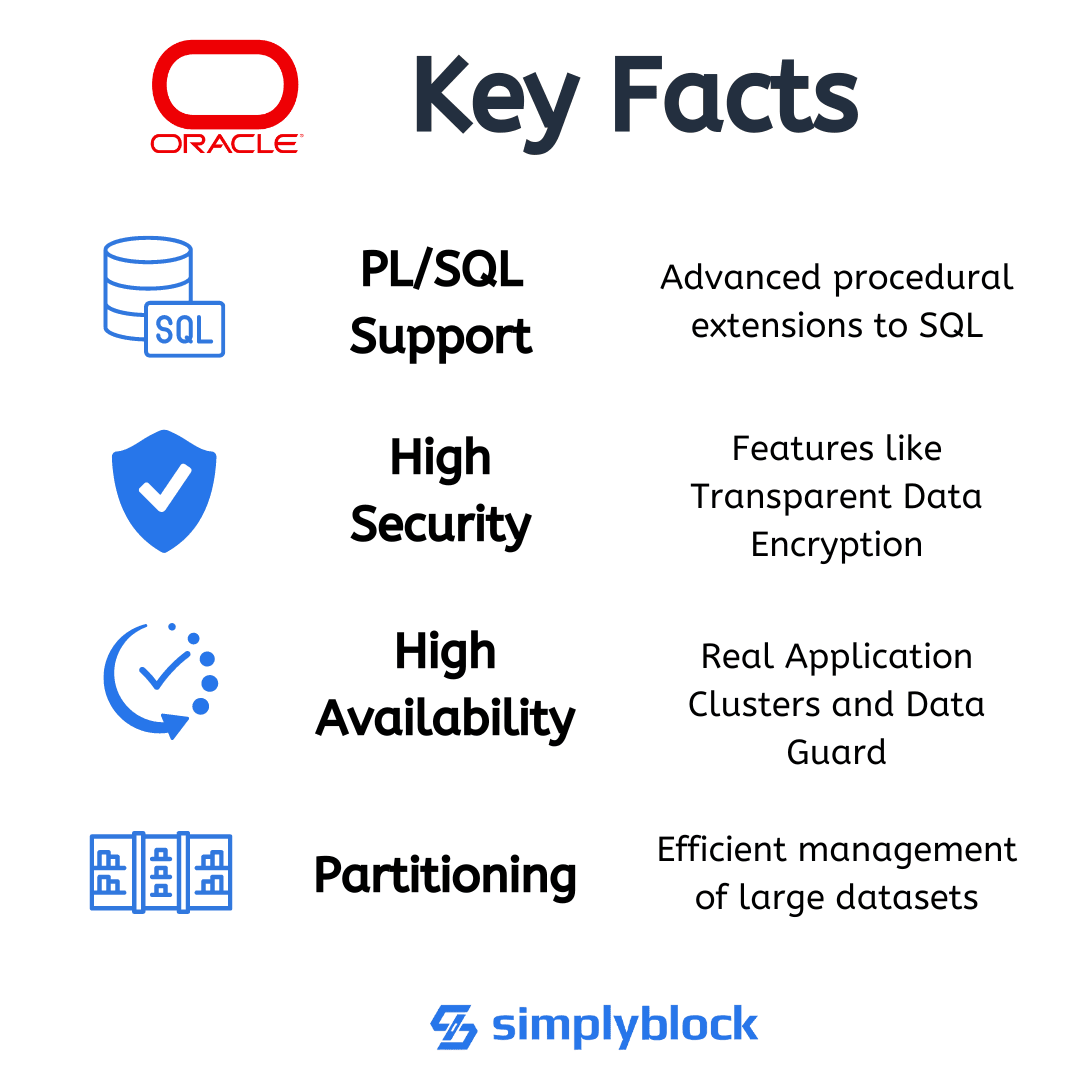Oracle Database
Terms related to simplyblock
Oracle Database is a relational database management system (RDBMS) developed by Oracle Corporation, designed to handle large-scale, mission-critical workloads across on-premises, hybrid, and cloud environments. Known for its robust architecture, security features, and high availability, it is widely used in banking, government, telecom, and healthcare sectors.
Oracle Database supports SQL and PL/SQL, provides deep integration with enterprise applications, and powers both transactional systems (OLTP) and analytical workloads (OLAP) using a unified engine.
Core Features of Oracle Database
Oracle has evolved over four decades into a feature-rich platform capable of addressing complex data challenges. Its core capabilities include:
- Multitenant Architecture: Enables isolation and consolidation via pluggable databases (PDBs) within a single container database (CDB).
- ACID-Compliant Transactions: Guarantees consistency and durability across distributed systems.
- Advanced Security: Offers data redaction, Transparent Data Encryption (TDE), and Database Vault for privileged access control.
- Oracle Real Application Clusters (RAC): Provides active-active clustering for high availability and load balancing.
- Data Guard: Enables disaster recovery with physical and logical standby databases.
- In-Memory Option: Accelerates analytics by storing columnar data in RAM.
- Advanced Indexing: Supports bitmap, function-based, and compressed indexes for performance optimization.
- Partitioning & Compression: Enhances large dataset handling with minimal resource consumption.
Oracle also integrates with enterprise tools like Oracle Fusion Middleware, E-Business Suite, and external platforms like SAP and Salesforce.

Oracle Database vs Other RDBMS Platforms
Oracle Database is often benchmarked against Microsoft SQL Server, PostgreSQL, and MySQL. While licensing is a consideration, Oracle offers enterprise-grade availability and resilience that few others match.
Comparison Table
| Feature | Oracle Database | Microsoft SQL Server | PostgreSQL | MySQL |
|---|---|---|---|---|
| License | Proprietary | Proprietary | Open-source | Open-source |
| Multitenant Architecture | Yes (PDB/CDB) | No | Partial (schemas) | No |
| Real-time Clustering | RAC | Always On AG | Streaming Replication | Galera (external) |
| In-Memory Processing | Yes | Yes (OLTP) | Extensions | No |
| Partitioning | Native | Yes | Manual | Manual |
| Best Fit For | High-end enterprise | Windows-centric infra | Open-source stacks | Web apps |
Oracle’s focus on resilience, clustering, and deep data lifecycle management makes it ideal for regulated, large-scale systems where uptime and compliance are non-negotiable.
Use Cases for Oracle Database
Oracle Database supports a wide variety of demanding use cases, including:
- Financial Systems: Real-time transaction processing with secure audit trails.
- Telecommunications: Customer and billing databases with ultra-low latency requirements.
- Government & Healthcare: Compliance-ready data protection and high availability.
- Enterprise Resource Planning (ERP): Backend for Oracle’s own Fusion ERP and SAP deployments.
- Data Warehousing: Combines transactional and analytical queries within the same engine using Oracle Autonomous Data Warehouse.
To ensure consistent performance in these environments, pairing Oracle Database with high-throughput, NVMe-class block storage like simplyblock™ enhances OLTP/OLAP capabilities while reducing latency.
Storage & Performance Optimization
Oracle workloads are I/O intensive, especially in RAC, OLAP, and backup scenarios. Key storage considerations include:
- Write-Ahead Logging (Redo Logs): Demands high write throughput and consistent latency.
- Temp Tablespaces & Sort Areas: Must be optimized for large scans and sorts.
- Datafiles & Indexes: Benefit from low-latency block storage with support for parallel I/O operations.
Deploying Oracle on NVMe over TCP with erasure coding via simplyblock ensures:
- Sub-millisecond latency for OLTP
- High IOPS for index scans and sorts
- Snapshots and clones for Dev/Test environments
- Thin provisioning for cost-effective capacity planning
Oracle Database in Kubernetes and Cloud
While Oracle traditionally runs in virtual machines and bare-metal deployments, it can be containerized with tools like Oracle Database Operator for Kubernetes and used with CSI drivers for persistent volumes.
Oracle Cloud Infrastructure (OCI) offers Oracle Autonomous Database, but for hybrid or edge use cases, Oracle can be deployed using StatefulSets in Kubernetes clusters with storage backed by simplyblock’s™ software-defined block layer. Benefits include:
- Cloud-agnostic storage abstraction
- NVMe over TCP support
- High availability via redundancy and fast failover
- Integrated support for disaster recovery and test data cloning
External References
- Oracle Database Official Site
- Multitenant Architecture
- Oracle RAC Overview
- PL/SQL Language
- Redo Logs and Oracle Write-Ahead Logging
Questions and Answers
Oracle Database is built for mission-critical workloads, offering advanced features like real application clusters (RAC), partitioning, in-memory processing, and strong consistency. It’s widely used in finance, healthcare, and telecom where performance, reliability, and compliance are non-negotiable.
Yes, Oracle provides container images and supports Kubernetes via Oracle Database Operator. To ensure persistent performance and stability, it should be paired with NVMe-based Kubernetes storage for fast IOPS, failover resilience, and high throughput.
Oracle workloads benefit from low-latency, high-throughput storage, especially for OLTP and data warehousing. NVMe over TCP or software-defined storage offers the speed and flexibility needed to handle large-scale transactional systems.
Yes, Oracle includes Transparent Data Encryption (TDE) as part of its Advanced Security option. For enhanced protection and isolation, you can combine TDE with storage-layer encryption-at-rest to comply with industry regulations like GDPR and HIPAA.
Oracle Database supports horizontal scaling, sharding, and multitenancy. When deployed with cloud-native storage solutions, it can scale efficiently while maintaining high availability and performance in hybrid and multi-cloud setups.
